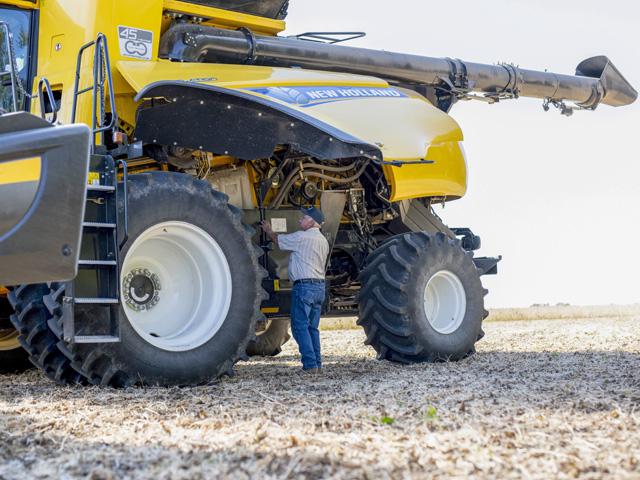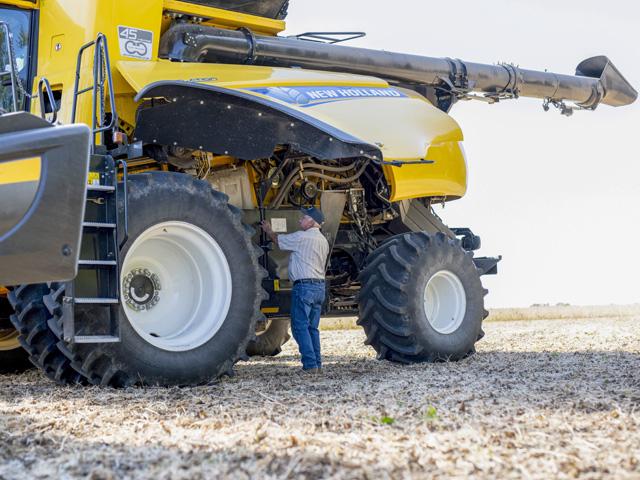MachineryLink
Here's a 10-Step Combine Maintenance Program for a Profitable Harvest
As harvest nears, you might want to make one last loop around the combine.
New Holland's parts and service product manager for harvesting, Jim Franceschetti, offers a 10-step maintenance program for good harvesting results. Top of the list -- although it's down toward the bottom of this article -- is calibration. But in preview of that, Franceschetti does not recommend reliance on last year's calibrations.
And so, here is Franceschetti's list of Top 10 Combine Maintenance Tips:
-- Safety routine. Start with safety glasses and other personal protective equipment (PPE). If you're looking at something from below, safety glasses keep dirt and other debris from falling into your eyes. Keep a spatial awareness around the combine for things like open side panels or the far edges of the headers. Check that the safety features of the combine are up to par -- think lights and fire extinguishers, plus a first aid kit.
-- Prevent fires. Keep an air compressor or leaf blower handy. When you shut down for the day, check under the side panels and thoroughly blow out the debris that may build up in the combine and on the header and feeder house.
P[L1] D[0x0] M[300x250] OOP[F] ADUNIT[] T[]
-- Pre-harvest prep. Give yourself ample time before harvest to look around the machine, familiarize yourself again with the technology, calibrate, and make sure that you're satisfied with all the settings.
-- Header adjustments. The goal is to get the cleanest cut possible, to move as much of the crop as possible into the header and fed through the feeder house and thresher to maximize yield. If you're harvesting corn, make sure the stalk rolls and stripper plates are spaced properly. If not done, significant grain loss may be the result. On the grain header, make sure the speed of the reels on the grain header matches the speed of the combine. These are checks that will help facilitate smooth, even crop flow into the cutter bar -- ensure the cutter bar is clean, by the way -- and then into the combine.
-- Chain wear. Check the feeder chains for wear. Check the flats, the rollers and tension. If there is excessive movement between the links, replace the chains. Check the chain bars in the feeder house. Make sure they are not bent or twisted. New Holland CR combines have the Dynamic Feed Roll feature that delivers harvested grain uniformly to the twin rotors while directing stones and other debris into a dedicated trap emptied automatically with the Dynamic Feed Roll reversing system. Streamlined feeding can increase capacity by up to 10%. It needs to be functioning correctly to ensure smooth crop flow into the threshing system.
-- Thresher performance. Good threshing performance is the result of balance between rotor speed and concave clearance. Cylinder or rotor speed is the leading cause of grain damage. Use the lowest possible rotor speed that will shell the grain. Three suggestions. First, tap into your dealership's knowledge base. You may operate one or two combines; they have seen dozens. They know tricks to match local field conditions to the operation of the combine. Second, as you make adjustments, make only one adjustment at a time. This helps pinpoint other adjustments that may need to be made. Three, newer combines are loaded with technology. It might have been a year since you last set eyes on your combine. Make sure those functions -- New Holland's IntelliSense combine automation system, for example -- are properly calibrated.
-- Clean grain. Calibrate the fan speed and make sure the sieve openings are correct. Consistency and speed help with even and smooth distribution to the twin rotors. You don't want grain piling up on one side or the other. That will result in uneven crop flow and may clog the combine threshing system. Most of these adjustments are made automatically.
-- Kill stall. Operators often do a kill stall to examine the actual harvesting functions of the combine. The kill stall puts the threshing process in a frozen state. It's a good way to check the adjustments made before harvest and to see how the combine is operating in the field.
-- The cab. Don't trust last year's harvest calibrations. Running multiple calibration loads provides greater accuracy when calibrating yield monitors. While harvesting calibration loads, get a reading on moisture by sampling each load with a calibrated meter. Use that data when calibrating the mass flow sensor.
-- Combine clinics. You might attend a combine clinic. This is a time for operators to get into the dealership, to learn from their experts and suppliers, and perhaps, manufacturer technicians and engineers. It also creates opportunities to speak with other producers and learn their successful practices and harvesting tricks.
Dan Miller can be reached at dan.miller@dtn.com
Follow him on Twitter @DMillerPF
(c) Copyright 2022 DTN, LLC. All rights reserved.





Comments
To comment, please Log In or Join our Community .